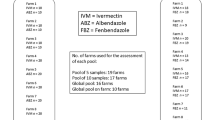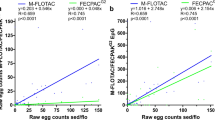Abstract
Three methods, FLOTAC, FECPAK and McMaster were compared for accuracy and sensitivity for counting numbers of nematode eggs in faeces of naturally infected cattle with high or low nematode egg counts. Only FLOTAC gave positive results for 12 replicates from pooled samples with low egg counts making it more sensitive than FECPAK (67%) and McMaster (41.7%). FLOTAC resulted in generally higher egg counts and lower coefficients of variation than the other two methods used. The reliability of FECPAK and McMaster is depended on the area under the slide counted. All three methods can be used for making decisions whether to treat but FLOTAC or Mini-FLOTAC should be used for faecal egg count reduction tests when lower egg counts are present.
Similar content being viewed by others
References
Coles G.C., Bauer C., Borgsteede F.H., Geerts S., Klei T.R., Taylor M.A., Waller P.J. 1992. World association for the advancement of veterinary parasitology (W.A.A.V.P.) methods for the detection of anthelmintic resistance in nematodes of veterinary importance. Veterinary Parasitology, 44, 35–44.
Cox D.D., Todd A.C. 1962. Survey of gastrointestinal parasitism in Wisconsin dairy cattle. Journal of the American Veterinary Medical Association, 141, 706–709.
Cringoli G., Rinaldi L., Veneziano V., Capelli G., Scala A. 2004. The influence of flotation solution, sample dilution and the choice of McMaster slide area (volume) on the reliability of the Mc-Master technique in estimating the faecal egg counts of gastrointestinal strongyles and Dicrocoelium dendriticum in sheep. Veterinary Parasitology, 123, 121–131.
Cringoli G., Rinaldi L., Maurelli M.P., Utzinger J. 2010. FLOTAC: new multivalent techniques for qualitative and quantitative copromicroscopici diagnosis of parasites in animals and humans. Nature Protocols, 5, 503–551. DOI: 10.1038/nprot.2009.235.
Cringoli G., Rinaldi L., Albonico M., Bergquist R., Utzinger J. 2103. Geospatial(s) tools: integration of advanced epidemiological sampling and novel diagnostics. Geospatial Health, 7, 399–404.
Egwang T.G., Slocombe J.O. 1982. Evaluation of the Cornell-Wisconsin centrifugal flotation technique for recoverins trichostrongylid eggs from bovine feces. Canadian Journal of Comparative Medicine, 46, 133–137.
Gordon H., Whitlock H.V. 1939. A new technique for counting nematode eggs in sheep faeces. Journal Council Scientific Industrial Research, 12, 50–52.
Levecke B., Rinaldi L., Charlier J., Maurelli M.P., Bosco A., Vercruysse J., Cringoli G. 2012. The bias, accuracy and precision of faecal egg count reduction test results in cattle using McMaster, Cornell-Wisconsin and FLOTAC egg counting methods. Veterinary Parasitology, 188, 194–199. DOI: 10.1016/j.vetpar.2012.03.017.
Levecke B., Rinaldi L., Charlier J., Maurelli M.P., Morgoglione M.E., Vercruysse, J., Cringoli G. 2011. Monitoring drug efficacy against gastrointestinal nematodes when faecal egg counts are low: do the analytic sensitivity and the formula matter? Parasitology Research, 109, 953–957. DOI: 10.1007/s00436-011-2338-z
MAFF, 1986. Manual of Veterinary Parasitological Techniques, Her Majesty’s Stationary Office, London (1986) 160 pp.
Mes T.H.M. 2003. Technical variability and required sample size of helminth egg isolation procedures. Veterinary Parasitology, 115, 311–320.
Presland S.L., Morgan E.R., Coles G.C. 2005. Counting nematode eggs in equine faecal samples. Veterinary Record, 156, 208–210.
Sutherland I.A., Leathwick D.M. 2011. Anthelmintic resistance in nematode parasites of cattle: global issue? Trends in Parasitology, 27, 176–181.
Author information
Authors and Affiliations
Corresponding author
Rights and permissions
About this article
Cite this article
Bosco, A., Rinaldi, L., Maurelli, M.P. et al. The comparison of FLOTAC, FECPAK and McMaster techniques for nematode egg counts in cattle. Acta Parasit. 59, 625–628 (2014). https://doi.org/10.2478/s11686-014-0282-7
Received:
Revised:
Accepted:
Published:
Issue Date:
DOI: https://doi.org/10.2478/s11686-014-0282-7




